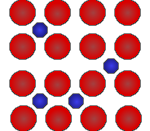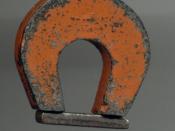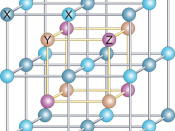An alloy is a solid solution or homogeneous mixture of two or more elements where a material with better or different properties is produced. The range of alloys produced depends on the solubility of the constituents and the proportion of them. The number of possible alloy combinations is almost endless since any metal can be alloyed in pairs or in multiples. Alloys can be classified into two main categories:Interstitial alloy.
It is when smaller elements, such as boron, carbon, nitrogen, or silicon, fill the spaces or interstice of the main metallic structure or solvent. For example, steel is an interstitial alloy in which carbon atoms fill the holes between the crystal structures of iron.
Substitutional alloyIt is formed when the solute atoms take up positions of solvent atoms in the crystal lattice. If the two metal atoms are about the same size and have the same crystallographic structure, then the two metals may form a solid solution.
Brass, an alloy composed of copper and zinc, is an example of a substitutional alloy.
Alloys have different applications depending on their properties. The various types of steel and iron are all alloys classifiable by their content of other materials. For instance, wrought iron has a very small carbon content, while cast iron has at least two percent carbon. Steels contain varying amounts of carbon and metals such as tungsten, molybdenum, vanadium, and cobalt, giving them the strength, durability, and anti-corrosion capabilities required by their different uses. Stainless steel, which has eighteen percent chromium and eight percent nickel alloyed to it, is valued for its anti-corrosive qualities. Some iron-based alloys like Alnico-4, consists of 55% iron, 28% nickel, 12% aluminium, and 5% cobalt, are used as magnets.
Other alloys, such as Nichrome, a nickel based alloy with 12-15% chromium and 25% iron, are very strong at high temperatures. They are used in power-generating plants, jet engines, and gas turbines. Alloys based on tin, cadmium, copper, or silver are used to make bearings which reduce friction between two sliding surfaces. Light weight alloys, like the aluminium, zinc, and magnesium system, are used in aircraft. Prosthetic devices, like artificial knees and hips, are made from high-strength, corrosion-resistant alloys that are usually based on iron, cobalt, or titanium.
Many alloys add function to physical beauty. For example, sterling silver is made with eight percent copper to add strength so that it can be made into chalices and silverware. All American coins are made from copper alloy, sometimes sandwiched between layers of silver. Dental fillings can be made from alloys of silver and mercury or alloys of gold, silver, and copper.
Alloys greatly enhance the versatility of metals. Without them there would be total dependency on pure metals, which would affect their cost and availability. Alloys are a very important part of humankind's past and future.
Bibliographyhttp://www.bookrags.com/research/alloy-woc/http://en.wikipedia.org/wiki/Alloyhttp://en.wikipedia.org/wiki/List_of_alloyswww.answers.com/topic/alloy-metalmetals.about.com/bldef-Alloy-Steel





